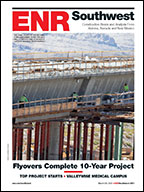At the Port of Immingham, on the east coast of England, contractor Costain Group plc., London, is piloting a smartphone-accessible system, called Smart Highways, to help with long-term highway asset management and maintenance.
The contractor, which is engaged on a contract to upgrade roughly 5 kilometers of the A160 highway at the port, is using the system's various tools to tag physical assets. This is the first time the technology has been used on a road project in the U.K.
Items tagged so far include lighting columns, signs, pavements, culverts and gullies. Full data on the objects are stored in the cloud and accessed and updated with smartphones from a website. Tagging technology includes radio frequency identification (RFID) tags, quick-response codes (QR codes) and 2D barcodes. Global-positioning-system tools, which require no physical tags, also are being deployed.
“When you click on an asset, you get every bit of information about that asset,” says Graham Starkey, Costain’s project BIM coordinator.
The system ensures that workers are sent to the correct locations, which, on active highways, is “important for health and safety reasons,” adds Starkey. Misdirection of maintenance crews contributes significant cost to conventional highway management, he says.
Form the owner’s viewpoint, “we can improve accuracy on the condition of those assets,” notes Ben Ridgeon, project manager with the government’s highway agency, Highways England.
The government-funded trial is being led by the Cambridge University spin-off RedBite Solutions Ltd., which developed the system. RedBite also is running a parallel trial for the industrial sector with Cambridge University.
At the end of the trial, “we will be able to say with confidence … whether these tags are suitable to be rolled out to further highways,” says Charlotte Broom, RedBite’s spokeswoman.





